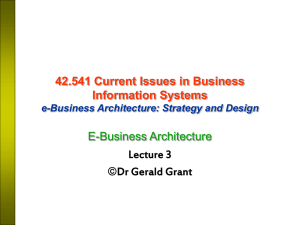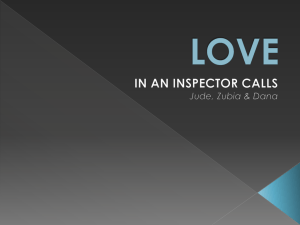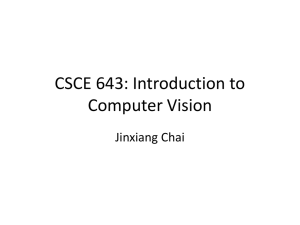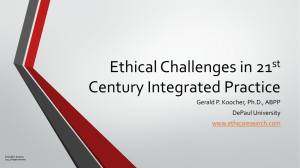Managing IT-enabled - Sprott School of Business
advertisement
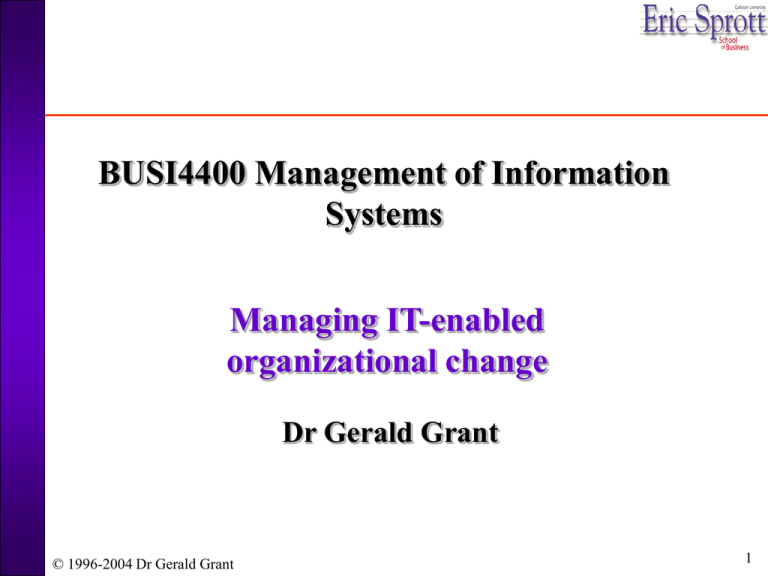
BUSI4400 Management of Information Systems Managing IT-enabled organizational change Dr Gerald Grant © 1996-2004 Dr Gerald Grant 1 Introduction The introduction of computer-based information systems into an organization should be viewed as a major technological innovation. Managing IT-enabled change is becoming more complex with time. © 1996-2004 Dr Gerald Grant 2 Introduction (continued) Benjamin and Blunt (1992 pp. 16-17) suggest that “the technology is allowing us to build ever larger and more complex systems, and supporting interdependent business processes will require those larger and more complex systems. Thus IT will continue to be involved in a change process that, at the same time, it makes more complex. IT complicates the change process in a number of ways: it moves the locus of knowledge and hence power in the organization, it changes the time dimension of processes and decisions, and it enables new organizational constructs to be implemented.” © 1996-2004 Dr Gerald Grant 3 Introduction (continued) “organizations must recognize that managing the change enabled by IT is at least as important as bringing IT into the organization” (Benjamin and Levinson, 1993, p.33). The success of any change management exercise is highly dependent on organizational members executing their roles effectively. These roles include: The leadership provided by top management, the implementing skills of middle management and the involvement of user personnel © 1996-2004 Dr Gerald Grant 4 Introduction (continued) However, according to Markus and Benjamin, (1997) Failure can still occur even when all parties are confident that they have done their jobs Both IT specialist and line managers frequently have and hold onto failure-promoting beliefs about their roles in change © 1996-2004 Dr Gerald Grant 5 Characteristics of IT-enabled change IT-enabled change processes are different from general change processes in a number of significant ways (Bejamin and Levinson, 1993) IT radically impacts skills, jobs and organizational control processes. Change reaches across functional and organizational boundaries IT shifts the balance of organizational knowledge and power Operational process cycles speed up IT changes work methods © 1996-2004 Dr Gerald Grant 6 Political nature of IT-enabled change Introducing IT-enabled change in organizations is more than just a technical issue. It is an intensely political issue as well (Keen 1981). Successful change interventions require the galvanizing of organizational commitment the building of support among affected groups the creation of a momentum for change These are substantially political processes. © 1996-2004 Dr Gerald Grant 7 Resistance to IT-enabled organizational change Resistance is defined as “behaviors intended to prevent the implementation or use of a system or to prevent systems designers from achieving their objectives” Markus (1983) Resistance can be viewed from different perspectives. © 1996-2004 Dr Gerald Grant 8 Resistance to IT-enabled organizational change Resistance is most often viewed as an undesirable behavior attributed to systems users. Alternatively, resistance may be desirable or undesirable depending on the setting, users and systems designers. Resistance may at times be beneficial to the organization. For example, if it prevents the implementation of systems with long term dysfunctional characteristics. © 1996-2004 Dr Gerald Grant 9 Reasons People Resist Change Luftman, et al. (2004 p. 278) Loss of face Loss of control Excess uncertainty Surprise The “difference effect” Competence concerns © 1996-2004 Dr Gerald Grant Change will affect other issues/roles More work Past resentments Real Threats Competing commitments 10 Who resists IT-enabled change ideas (Markus and Benjamin, 1997) IT specialists too fond of the latest technology resistant to new technology ideas because of gaps in their own knowledge and expertise, inability to cope with support demands, etc. © 1996-2004 Dr Gerald Grant 11 Who resist IT-enabled change ideas (Markus and Benjamin, 1997) Line managers may insist on the exclusive right to make technology decisions even if alternative solutions which fully meet business goals are suggested by others, particularly users. Users Fear the impact of IT on their jobs and careers May genuinely feel that proposed solutions will not work. © 1996-2004 Dr Gerald Grant 12 Theories of resistance: Resistance to IT-enabled change can be viewed from a number of theoretical perspectives (Markus, 1983) good theories about resistance are essential in dealing effectively with the phenomena. Three theoretical perspectives: people-determined System-determined Interaction theory © 1996-2004 Dr Gerald Grant 13 Theories of resistance and their implications (adapted from Markus, 1983) 1. People determined 2. System determined Why Resistance Occurs People resist ITinduced change because they don’t like or want to change. 3. Interaction Theory People resist change because of poor technical systems design and development People resist change because of the impact of the change on the social and political context: IT may alter relationships and power structures © 1996-2004 Dr Gerald Grant 14 Theories of resistance and their implications (adapted from Markus, 1983) 1. People determined Cognitive: 2. System determined Analytical Perspective from which resistance is viewed Focus on individual traits 3. Interaction Theory Technical: Emphasis on technical design issues Socio-technical and political: Focus on interaction between technical and socio-political factors © 1996-2004 Dr Gerald Grant 15 Theories of resistance and their implications Dealing with resistance (adapted from Markus, 1983) People-determined View Select people open to change Educate users (training) Coerce users (edicts and policies) Persaude users Involve users in design and development to obtain commitment © 1996-2004 Dr Gerald Grant 16 Theories of resistance and their implications Dealing with resistance (adapted from Markus, 1983) System-determined View Educate systems designers (better technology) Improve human-computer interface Modify systems to conform to how people actually work Involve users in the design process to get better designs © 1996-2004 Dr Gerald Grant 17 Theories of resistance and their implications Dealing with resistance (adapted from Markus, 1983) Interaction Theory View Introduce organizational changes before implementing systems Restructure incentives for users Restructure relationships between users and designers (eg. decentralizing responsibility for systems development) Recognize that participation is not always appropriate © 1996-2004 Dr Gerald Grant 18 A framework for managing change (Mento, Jones, Dirndorfer, 2002) Highlight the idea and context for change Define the change initiative Evaluate the climate for change Develop a change plan Find and cultivate a sponsor Prepare your target audience, the recipients of change Create the cultural fit – making the change last Develop and choose the change leader team Create small wins for motivation Constantly and strategically communicate the change Measure progress of the change effort Integrate lessons learned © 1996-2004 Dr Gerald Grant 19 IT-enabled change is difficult Markus and Benjamin (1997) suggests that there are no ‘magic bullets’ in ITenabled organizational change. Such change involves much hard work and must deliberately involve people at all levels, technologists, entrepreneurs, and users. © 1996-2004 Dr Gerald Grant 20 IT-enabled change is difficult “only users behaving mindfully can achieve appropriate and effective use of IT. Users must understand and accept the idea of and reasons for change. They must also thoroughly understand not only how to use IT but also how to use it to accomplish desired results”. (Markus and Benjamin, 1997 p. 59) © 1996-2004 Dr Gerald Grant 21 Roles for IT-enabled change agents (Markus and Benjamin, 1997) IT Change Facilitators: Focus on bringing together all the resources necessary to effect change: good technologies, supportive organizational conditions, and knowledgeable, mindful users Empower people about IT, expanding their opportunities to learn more about IT and organizational change and to participate more effectively in decisions about IT. Help organizational members to accept their IToriented behaviors © 1996-2004 Dr Gerald Grant 22 Roles for IT-enabled change agents (Markus and Benjamin, 1997) IT Change Facilitators: Advantages: improves chances of implementation success by focusing attention on what works. builds mutual respect between organizational members and groups Who can be IT change facilitators? neutral party - consultant or person from other department IT specialists or business executive © 1996-2004 Dr Gerald Grant 23 Roles for IT-enabled change agents (Markus and Benjamin, 1997) IT change advocate role: Focuses on inspiring organizational members to embrace IT-enabled organizational change. Uses any means including overt persuasion, covert manipulation, symbolic communication, and sometimes exercise of formal power to effect desired change. Focuses is on getting results. © 1996-2004 Dr Gerald Grant 24 Roles for IT-enabled change agents (Markus and Benjamin, 1997) IT change advocate role: Advantages of change advocates: They are especially useful when benefits of IT implementation cannot be ascribed to one particular group, e.g. in large scale IT infrastructure projects. Who can perform advocacy role? business managers, IT specialists, users © 1996-2004 Dr Gerald Grant 25 Successful change mangement (Markus and Benjamin, 1997) Involves: listening understanding giving people a chance to learn designing learning experiments visualizing and dramatizing ideas Takes good ideas, skill and hard work Is everyone’s job © 1996-2004 Dr Gerald Grant 26 Introducing IT into organizations: three generic strategies (Mckersie and Walton, 1991) Preemptive organizational change followed by IT implementation. This envisages a situation where organizational changes have already been effected in preparation for the implementation of IT. IT is pulled into place by the users rather than pushed by sponsors or superiors (Mckersie and Walton, 1991, p. 251) © 1996-2004 Dr Gerald Grant 27 Introducing IT into organizations: three generic strategies (Mckersie and Walton, 1991) Simultaneous implementation of organizational change and IT. allows mutual adaptation of the technical and social subsystem of an IT installation (Mckersie and Walton, 1991, p.253).. © 1996-2004 Dr Gerald Grant 28 Introducing IT into organizations: three generic strategies (Mckersie and Walton, 1991) Introduction of IT systems without adjusting the prevailing organizational arrangements. deliberate choice to use technology to push the organization to change and adopt new ways of operating. IT is seen as a catalyst that will generate the need for change. © 1996-2004 Dr Gerald Grant 29 User participation and involvement in IT design and implementation The involvement of users and other stakeholders in the design, development and introduction of IT systems is generally well accepted among IT practitioners and managers. User participation is seen as a precursor to commitment and effective use of the systems. Researchers and practitioners alike have demonstrated the practical benefits of user participation in systems design and development © 1996-2004 Dr Gerald Grant 30 Benefits of user participation and involvement Systems that more fully meet user needs More user commitment to and ownership of IS project Less resistance to new systems Potential for more effective use of the system Increased opportunities for learning to take place Greater overall productivity © 1996-2004 Dr Gerald Grant 31 User participation - not a panacea Some of the difficulties presented by extensive user involvement include: users are likely to protect their own vested interests as opposed to supporting corporate objectives. systems that are highly specified and require tight integration with other systems may limit the extent of user participation. users may demand too many features that cannot realistically be incorporated into the design and implementation. systems that span multiple sites and functions may present difficulties in involving all the relevant users. © 1996-2004 Dr Gerald Grant 32 Human resource policies supporting ITenabled change programs McKersie and Walton (1991) Work organization and job design In order to benefit from new IT systems managers must ensure that jobs are designed to take best advantage of the properties of the new technologies while increasing their motivating, competence building and communication properties. © 1996-2004 Dr Gerald Grant 33 Human resource policies supporting ITenabled change programs - McKersie and Walton (1991) Selection of potential users Incumbent workers whose job are affected by the new systems Training them to operate the new technologies may bring greater synergy and increased motivation. Sometimes entirely new workers may be brought in to enhance the skills base and change the operational culture. © 1996-2004 Dr Gerald Grant 34 Human resource policies supporting ITenabled change programs -McKersie and Walton (1991) Training A significant number of systems implementations fail because employees received inadequate training in using the new systems. Training consumes substantial resources. Training, whether formal or informal, on-the-job or in classrooms, provide the base on which user competence is built. Highly competent employees provide the basis for successful systems use and exploitation. © 1996-2004 Dr Gerald Grant 35 Human resource policies supporting ITenabled change programs -McKersie and Walton (1991) Employment security The introduction of information technology creates instability in affected parts of the organization. People become more uncertain of their jobs, particularly if they feel vulnerable. Consequently, employees may start looking for alternative employment even when they may not be affected by change © 1996-2004 Dr Gerald Grant 36 Human resource policies supporting ITenabled change programs -McKersie and Walton (1991) Employment security Companies which do not engage in effective human resources planning may find themselves without the very workers they need to improve productivity and derive business value from IT. Successful organizations will engage in effective human resources planning, avoiding the negative consequences of unplanned staff departure. © 1996-2004 Dr Gerald Grant 37 Human resource policies supporting ITenabled change programs -McKersie and Walton (1991) Performance monitoring and employee appraisal Monitoring performance and providing feedback to employees is an important part of the systems implementation and change management processes. Employees benefit most from appraisal and feedback designed to support competence development and personal growth. Appraisal with strictly punitive goals will be less successful. © 1996-2004 Dr Gerald Grant 38 References Markus, M. L. (1983) Power, politics and MIS implementation, Communications of the ACM, 26(6), pp. 430-444. Markus, M. L. and Benjamin, R. I. (1997). The magic bullet theory in IT-enabled transformation. Sloan Management Review, (Winter) pp. 55-68. McKersie and Walton (1991) Mento, A. J., Jones, R. M., and Dirndorfer, W. (2002) A change management process: grounded in both theory and practice, Journal of Change Management, 3(1), pp. 45-59. © 1996-2004 Dr Gerald Grant 39




